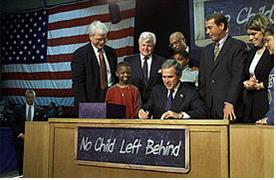
Curriculum
WIKIPEDIA | 2014-05-22 16:27

President George W. Bush signing the No Child Left Behind Act
There is debate over which subjects should receive the most focus, with astronomy and geography among those cited as not being taught enough in schools.
English in the classroom
An issue facing curricula today is the use of the English language in teaching. English is spoken by over 95% of the nation, and there is a strong national tradition of upholding English as the de facto official language. Some 9.7 million children aged 5 to 17 primarily speak a language other than English at home. Of those, about 1.3 million children do not speak English well or at all.
Evolution in Kansas
In 1999 the School Board of the state of Kansas caused controversy when it decided to eliminate teaching of evolution in its state assessment tests. Scientists from around the country demurred. Many religious and family values groups, on the other hand, claimed that evolution is simply a theory in the colloquial sense, and as such creationist ideas should therefore be taught alongside it as an alternative viewpoint. A majority supported teaching intelligent design and/or creationism in public schools.
Sex education
Almost all students in the U.S. receive some form of sex education at least once between grades 7 and 12; many schools begin addressing some topics as early as grades 4 or 5. However, what students learn varies widely, because curriculum decisions are so decentralized. Many states have laws governing what is taught in sex education classes or allowing parents to opt out. Some state laws leave curriculum decisions to individual school districts.
For example, a 1999 study by the Guttmacher Institute found that most U.S. sex education courses in grades 7 through 12 cover puberty, HIV, STDs, abstinence, implications of teenage pregnancy, and how to resist peer pressure. Other studied topics, such as methods of birth control and infection prevention, sexual orientation, sexual abuse, and factual and ethical information about abortion, varied more widely.
However, according to a 2004 survey, a majority of the 1001 parent groups polled wants complete sex education in the schools. The American people are heavily divided over the issue. Over 80% of polled parents agreed with the statement "Sex education in school makes it easier for me to talk to my child about sexual issues," while under 17% agreed with the statement that their children were being exposed to "subjects I don't think my child should be discussing." 10 percent believed that their children's sexual education class forced them to discuss sexual issues "too early." On the other hand, 49 percent of the respondents (the largest group) were "somewhat confident" that the values taught in their children's sex ed classes were similar to those taught at home, and 23 percent were less confident still. (The margin of error was plus or minus 4.7 percent.)
Textbook review and adoption
In some states, textbooks are selected for all students at the state level, and decisions made by larger states, such as California and Texas, that represent a considerable market for textbook publishers and can exert influence over the content of textbooks generally, thereby influencing the curriculum taught in public schools.
In 2010, the Texas Board of Education passed more than 100 amendments to the curriculum standards, affecting history, sociology and economics courses to 'add balance' given that academia was 'skewed too far to the left'.
This effect is however reduced with modern publishing techniques which allow books to be tailored to individual states.
As of January 2009, the four largest college textbook publishers in the United States were: Pearson Education (including such imprints as Addison-Wesley and Prentice Hall), Cengage Learning(formerly Thomson Learning), McGraw-Hill, Houghton Mifflin Harcourt. Other US textbook publishers include: John Wiley & Sons, Jones and Bartlett Publishers, F. A. Davis Company,W. W. Norton & Company, SAGE Publications, and Flat World Knowledge.
Share this page



















